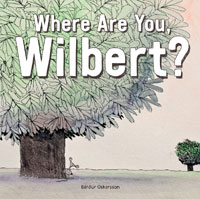| ________________
CM . . .
. Volume XXIV Number 19. . . .January 19, 2018

 |
Where Are You, Wilbert?
Bárdur Oskarsson. Translated by Marita Thomsen.
Toronto, ON: Owlkids Books, 2017.
36 pp., hardcover, $18.95.
ISBN 978-1-77147-301-9.
Preschool-grade 3 / Ages 3-8.
Review by Jill Griffith.
**** /4
|
| |
|

excerpt:
The crocodile looked long and hard at the tree and then she looked around the tree, but she couldn’t see any sign of Wilbert.
Mouse and Crocodile engage in a game of hide and seek, looking for Mouse’s friend Wilbert. As hard as Crocodile tries, and as close as he looks, he cannot see what Mouse sees, giving the reader not only a game of hide and seek but also a game of perspective.
The author of the profound and thoughtful The Flat Rabbit brings us a new title that makes us question how we look at our surroundings. The story is spare – often only three dots on a page either as ellipses or those three little dots we see when someone is contemplating their next text message – but the words are carefully chosen to evoke the theme. A shout-out to Oskarsson’s translator, Marita Thomsen, who has ensured that nothing is lost in translation. Perspective is the theme of both the text and the illustrations, but one must see the book to understand how Wilbert is both big and small, can hide behind a tree, or hide in plain sight. Oskarsson is a genius of both minimalism and understatement, making his books equally provocative for both children and adults.
Bárdur Oskarsson is both an extraordinary author and illustrator. His soft watercolours, as well as ink illustrations, lead the reader on various journeys. The watercolours are always on the right side of the double-page spreads. There is always an ink drawing on the text side of the story, which provides the reader with a subtext to follow, either hinting at what is to come or just providing an additional storyline. They also appear on all of the endpapers. Either way, these ink drawings add a subtle humour to the tale. The sympathetic characters are created more with illustration than with text, their odd proportions and facial expressions delightfully strange yet endearing.
I would like to suggest that Where Are You, Wilbert? be taken at face value as I’m not a fan of overt morals or lessons in picture books. In an oh-so-subtle manner, however, Oskarsson has shown children and their grownups that everyone sees the world differently so take the lesson, if you must. The expression “can’t see the forest for the trees” applies well here, and it is an especially poignant lesson for grownups when listening to their children. Often children see what others don’t or, try as they may, they are unable to see what we, as grownups, observe. Some wonderful discussion will ensue with even the youngest of children. I wish I could be a part of them all.
Highly Recommended.
Jill Griffith is the Youth Services Manager at Red Deer Public Library in Red Deer, AB.

© CM Association
CC BY-NC-ND
Hosted by:
University of Manitoba
ISSN 1201-9364
|
This Creative Commons license allows you to download the review and share it with others as long as you credit the CM Association. You cannot change the review in any way or use it commercially.
Commercial use is available through a contract with the CM Association. This Creative Commons license allows publishers whose works are being reviewed to download and share said CM reviews provided you credit the CM Association. |
Next Review | Table of Contents for This Issue - January 19, 2018.
CM Home | Back Issues | Search | CM Archive | Profiles Archive
|
